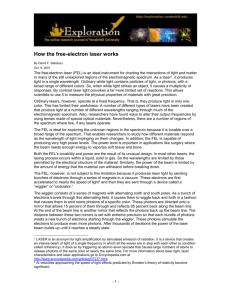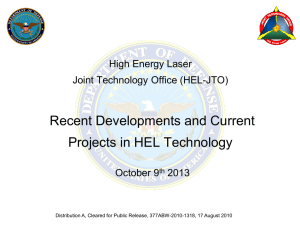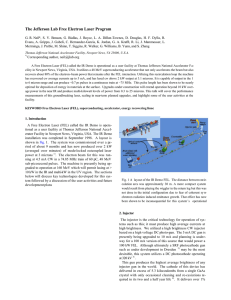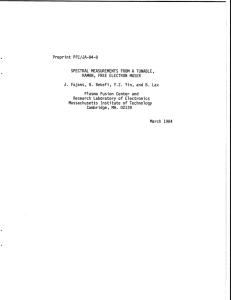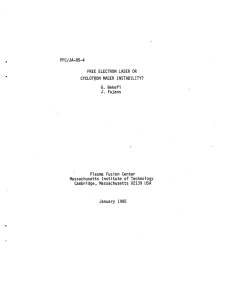September 20-September 24, 2010
advertisement
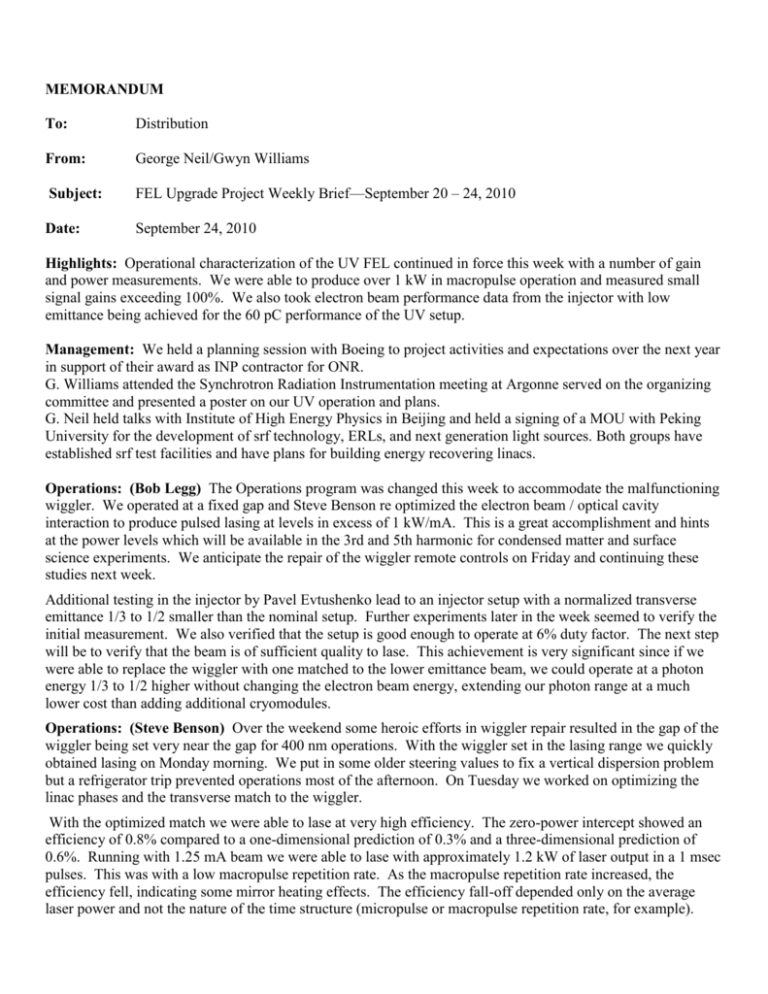
MEMORANDUM To: Distribution From: George Neil/Gwyn Williams Subject: FEL Upgrade Project Weekly Brief—September 20 – 24, 2010 Date: September 24, 2010 Highlights: Operational characterization of the UV FEL continued in force this week with a number of gain and power measurements. We were able to produce over 1 kW in macropulse operation and measured small signal gains exceeding 100%. We also took electron beam performance data from the injector with low emittance being achieved for the 60 pC performance of the UV setup. Management: We held a planning session with Boeing to project activities and expectations over the next year in support of their award as INP contractor for ONR. G. Williams attended the Synchrotron Radiation Instrumentation meeting at Argonne served on the organizing committee and presented a poster on our UV operation and plans. G. Neil held talks with Institute of High Energy Physics in Beijing and held a signing of a MOU with Peking University for the development of srf technology, ERLs, and next generation light sources. Both groups have established srf test facilities and have plans for building energy recovering linacs. Operations: (Bob Legg) The Operations program was changed this week to accommodate the malfunctioning wiggler. We operated at a fixed gap and Steve Benson re optimized the electron beam / optical cavity interaction to produce pulsed lasing at levels in excess of 1 kW/mA. This is a great accomplishment and hints at the power levels which will be available in the 3rd and 5th harmonic for condensed matter and surface science experiments. We anticipate the repair of the wiggler remote controls on Friday and continuing these studies next week. Additional testing in the injector by Pavel Evtushenko lead to an injector setup with a normalized transverse emittance 1/3 to 1/2 smaller than the nominal setup. Further experiments later in the week seemed to verify the initial measurement. We also verified that the setup is good enough to operate at 6% duty factor. The next step will be to verify that the beam is of sufficient quality to lase. This achievement is very significant since if we were able to replace the wiggler with one matched to the lower emittance beam, we could operate at a photon energy 1/3 to 1/2 higher without changing the electron beam energy, extending our photon range at a much lower cost than adding additional cryomodules. Operations: (Steve Benson) Over the weekend some heroic efforts in wiggler repair resulted in the gap of the wiggler being set very near the gap for 400 nm operations. With the wiggler set in the lasing range we quickly obtained lasing on Monday morning. We put in some older steering values to fix a vertical dispersion problem but a refrigerator trip prevented operations most of the afternoon. On Tuesday we worked on optimizing the linac phases and the transverse match to the wiggler. With the optimized match we were able to lase at very high efficiency. The zero-power intercept showed an efficiency of 0.8% compared to a one-dimensional prediction of 0.3% and a three-dimensional prediction of 0.6%. Running with 1.25 mA beam we were able to lase with approximately 1.2 kW of laser output in a 1 msec pulses. This was with a low macropulse repetition rate. As the macropulse repetition rate increased, the efficiency fell, indicating some mirror heating effects. The efficiency fall-off depended only on the average laser power and not the nature of the time structure (micropulse or macropulse repetition rate, for example). With such a high efficiency we had more problems transporting the beam cleanly to the energy-recovery dump so we spent some time cleaning up the transport. We then worked on measuring the gain and loss of the new laser setup at 400 nm. The loss was approximately 10.5% and the net gain was over 100%. The laser was turning on in about 4 usec. The one-dimensional net gain prediction is 75%. We took gain curves as a function of cavity length. On late Wednesday and all of Thursday we worked on characterizing the electron beam. We took beam images necessary for re-characterizing the Twiss parameters for the new match and worked on setting up a new injector configuration that seems to show much smaller transverse emittance than the usual setup. Injector: The FEL DC gun continued providing electron beam for UV FEL operations. There has been no need to replenish the photocathode QE since Sept 15. Issues with injector configuration control are being addressed. We are also working on proposals after Fay Hannon, Pavel Evtushenko, and Carlos HernandezGarcia received each letters of encouragement to submit full proposals answering the Office of Science call LAB10-395 "Early Career Program". RF: The RF Control Module for Quarter 4 cavity was replaced today as the possible culprit of a slow drift in the gradient for this cavity. It will be checked for drifts during operations next week. By directing a fan on the waveguide sweeps of cavities 1 & 2 of zone 2, the Cavity Waveguide Window Temperature (CWWT) faults have stopped. I am getting quotes for ZnSe windows to be able to check the temperatures of the warm windows with a FLIR camera. Gun HVPS: The HVPS is fully operational and still running on 1 driver stack. Instrumentation and Control: Some time this week was devoted to operations and assisting with running the machine for Gain/Loss measurements. Also this week, the group prepared for today's maintenance day. The completion of the control chassis for the Injector shorting switch was completed and bench tested. This has been installed and tested with the entire system and the operation verified. Currently we are going through several of the problematic UV BPM electronics and corrected the issues with each of them. As of now 1 out of the 4 are completed and back installed. The other three are in the testing phase and will be installed by close of business today. Weekend support was provided for re-establishing safe control of the UV wiggler. Support was used from STI to verify correct configuration and operation of the motor controls. The prognosis was there is inconsistent communication with the motor controller, resulting in the need to reset the system often. Tracking of this controller showed that it was returned to the manufacturer early on due to strange behavior. We have a replacement controller on order and we are working with STI to develop a procedure for swapping it out. The bad home switch is being replaced. Afterward, the encoders will be calibrated. We are also positioning the minimum gap limit switches due to the vacuum chamber being thicker than originally specified. The OCMMS FPGA board assembly was completed this week. Testing is in progress. The design of the OCMMS analog board was completed and the gerbers were sent to the board house for manufacture. They will be delivered next Thursday. The design of the OCMMS relay board is in progress and should be done by mid next week. CSC is performing a review on the security and handling of sensitive information. We are presenting to the review committee the FEL's security measures and our relation to sensitive science and technology. Optics: The design of the UV Collimator continued this week. Inventory is being assessed to determine what we can salvage from the old IR Collimator. The VUV OTS CAD model nears completion. Two DC motors that drive the water chillers were rebuilt. This morning were are installing a new 32m long fiber optic line from the UV diagnostic hutch up to the OCR. Also three quads, 6F05, 06 and 07, are being surveyed to determine if there is any vertical offset. Lasers and Optical Diagnostics: We continued with more laser damage tests on different samples this week. Data is being analyzed for a report. We reviewed and made changes on the new diagnostic configuration for UV FEL to prevent damage during high power operation. Spectral measurement and calibration of optical fibers are being performed as a further step to enhance the existing FEL diagnostic capability. We made plans for the improvement needed on the drive laser diagnostics requested by the operation group. We attended the Boson seminar for dark-matter search hosted by the Physics Division and had discussion with colleagues on the proposal requiring the use of the FEL machine. We did a complete check out on the beam Halo measurement system and observed the first synchrotron light with low duty-cycle electron beam. UV and IR FEL Modeling and Simulation: This week we collected more gain and now loss data while lasing at ~400nm. Pavel completed the standalone version of his analysis software so I’ve started looking through the enormous amount of data collected. We continue to work on simulating the transverse mode profiles of the harmonics. Time dependent (4D) FEL simulations have proceeded quite slowly because one must scan the cavity length to find the peak in both gain and power. In principle this should be fairly easy, but in practice, at least with our only 4D code (Medusa) it is difficult. Research continues on identifying vendors for our VUV optical transport, and sources of loaned equipment for diagnostics. The good news is that the reflectivity in the 124nm region of the spectrum is fairly high (of order 75%) so we should have good throughput to the user lab. JTO: Nothing new to report for this week. Terahertz: This week, we finished preparation of our presentation for the EFree Annual Meeting at the Carnegie Institution of Washington at the end of this week. We are presenting our THz transmission measurements through a diamond anvil cell (DAC) loaded with a 100 m aperture. Others will be presenting their progress and contributions to the collaboration’s study of material under extreme conditions. We will be looking for feedback on our progress and guidance on our future experiments and studies. Lab 5: Raja has performed several polymer depositions with the HIPPO 1064 nm onto the NaCl substrates and will begin the analysis on these films shortly. Also, we have designed a new set of tests for the laser melting/smoothing of Nb. We will be performing a set of laser surface processing experiments to study the time scales over which the surface melting and thermal diffusion occurs.
